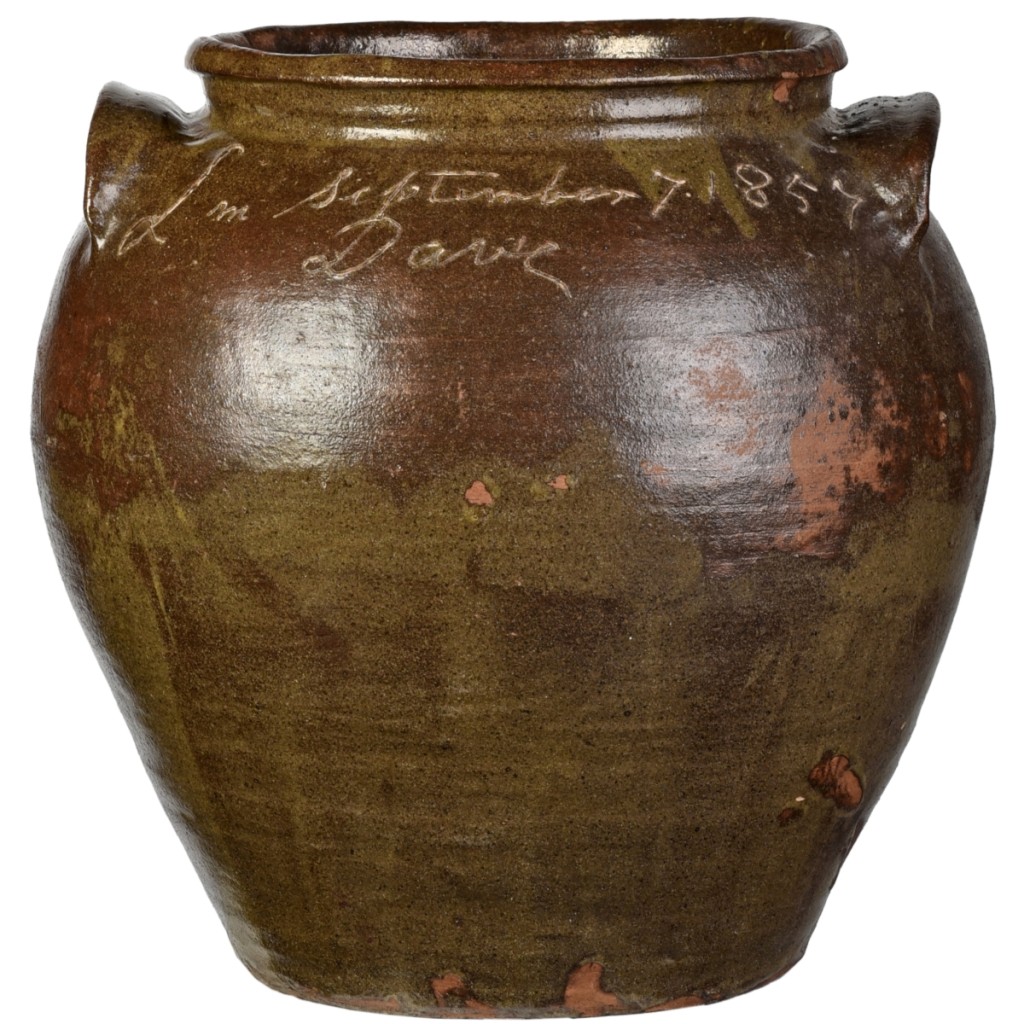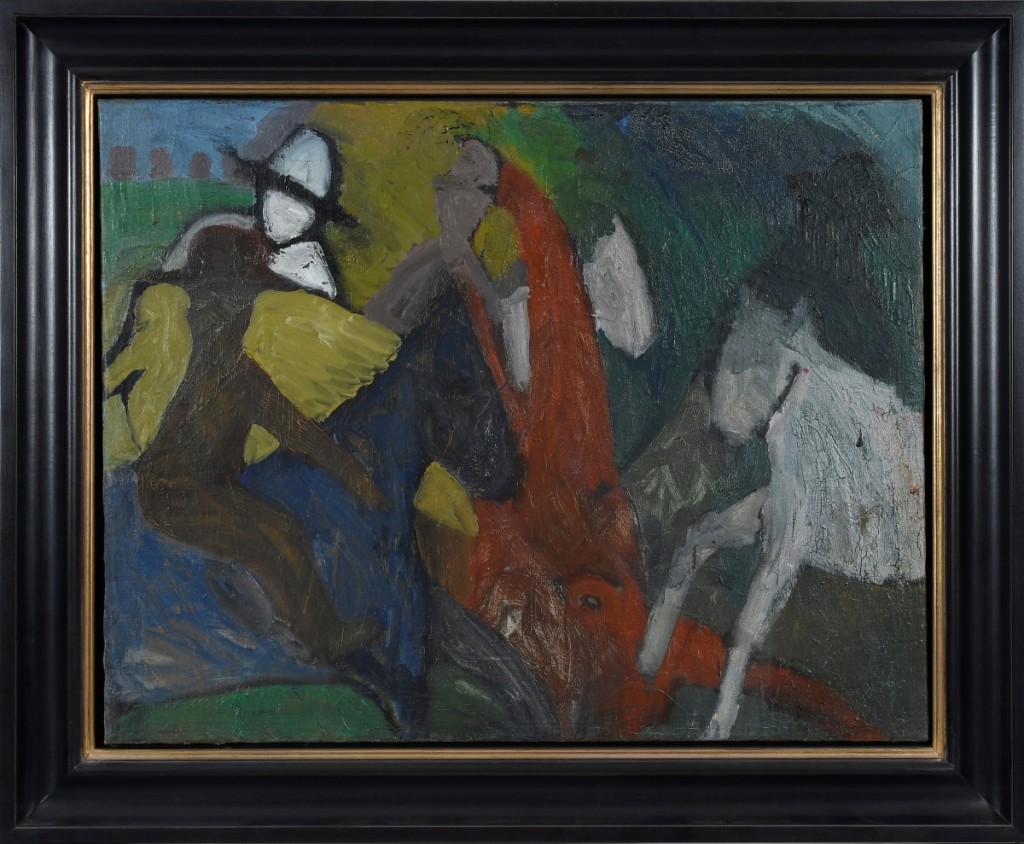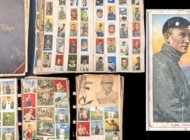
Leading the sale and securing a record price for a work by the maker in the process was this monumental “Dave” Edgefield stoneware jar, that achieved $184,500 from an undisclosed institution bidding on the phone ($40/60,000).
Review by Madelia Hickman Ring, Catalog Photos Courtesy Brunk Auctions
ASHEVILLE, N.C. – Brunk Auctions followed its 573-lot Emporium Auction on Friday, February 7 with a 530-lot Premier Auction on February 8. The combined sales brought $1,766,099 for the firm, which saw more than 94 percent of lots selling. Interest came from 16 countries and six continents, with 45 percent of the sale selling to internet bidders, 22 percent going to buyers in the room and phone bidders winning 15 percent of the lots.
Andrew Brunk, president of Brunk Auctions, remarked, “We’re happy to start off 2020 with strong results from our first premier and emporium auctions of the year. I think these results show a continuing demand for quality across categories and the outstanding sell-through rates speak to a widening customer base. We look forward to another strong performance in March.”
The sales were indisputably led by the now record price of $184,500 for an 18-inch-tall “monumental” stoneware jar made in 1857 by Dave the potter, a slave who had been owned by Harvey Drake in Edgefield, S.C. The jar received considerable interest and multiple phone lines vied for it, with an undisclosed American museum bidding on the phone securing the winning bid.
Speaking after the sale, Corey Jones, Brunk Auctions’ expert in Southern pottery, further justified the record-setting price. “There were no apologies on that piece. The condition was really, really good and the inscription was really sharp. The glaze was one like I’ve not seen and it’s a very desirable form.” Jones also confirmed that the provenance – the Shank collection of Edgefield pottery as well as to Brad Rauschenberg and Judy Aanstad, not to mention having been illustrated in a 1998 issue of The Magazine Antiques – also contributed to the success of the jar.
Prominent provenance, an exhibition history and documentation within the scholarly literature on an artist usually align with strong sales results. That proved true for Pio Fedi’s 1842 carrara marble statue of “Cleopatra morente,” which depicted Cleopatra holding an asp to her breast. The work is cited in many publications on the artist and was executed during the period Fedi spent in Vienna and Rome while working in Pietro Tenerani’s workshop. It had provenance to Harold Koplar of St. Louis, Miss., who built the Chase Park Plaza, where this sculpture was displayed before going into the private collection of an Atlanta, Ga., restauranteur. The price of $147,600 established a new record for the artist, handily beating the previous record of $106,640 set at Sotheby’s London on December 11, 2019.
-1024x778.jpg)
A phone bidder won Pio Fedi’s “Cleopatra morente” for $147,600, setting a new world auction record for the artist ($20/30,000).
Bringing $46,740 was “Riders on Horseback” by Bob Thompson (Kentucky/New York/Rome, 1937-1966). The lot was featured in a retrospective of the artists’ work at the Whitney Museum of American Art in New York City; a copy of the exhibition catalog was included with the lot, which sold to a phone bidder. Other Southern artists made a strong showing at the sale, most notably Alfred Heber Hutty’s watercolor “Charleston Corner” that tripled its high estimate to bring $27,060, while a watercolor seascape with sailboats by Alice Ravenel Huger Smith (1876-1858) brought $19,200, more than double its high estimate
Flying past its estimate to land at $35,840 was a Tiffany Studios Dragonfly lamp with bronze base impressed “Tiffany Studios/NY/1585” and “TDGCo.” The lamp had been purchased in Paris around 1950 and had descended in the family of a private collection in Spartanburg, S.C. Bringing $22,140 was an Art Deco music stand by Wilhelm Hunt Diederich that had been exhibited at the Renwick Gallery, the American Folk Art Museum and at Southern Illinois University in Carbondale, Ill., and had, at one time, been owned by harpist Margaret Ross Diederich, wife of Wilhelm Hunt. Quadrupling its low estimate and selling for $19,680 was a craft pitcher by Joseph Meyer of New Orleans, circa 1885-1890, that was illustrated in Louisiana’s Art Nouveau: The Crafts of the Newcomb Style.
Topping the offerings of Southern furniture was an Eighteenth Century brass inlaid tall case clock with spandrels engraved “Josa Lockwood Charles Town,” which a Southern buyer on the phone won for $29,520. The clock relates to three examples in the Museum of Early Southern Decorative Arts (MESDA) photo files, one with similar moon-phases dial, the other two with comparable pagoda bonnets. The example Brunk was selling had been in the estate of Dr G. Fraser Wilson of Charleston, S.C.
Other notable sales of Charleston furniture included a Charleston Federal mahogany two-drawer stand that achieved $2,706 and a Charleston Federal mahogany tall post bed that made $8,610. A Chippendale walnut desk attributed to the school of James Gheen exceeded expectations to sell for $1,476, and two Southern Federal chests of drawers made $6,765 for an inlaid example and $2,091 for one attributed to Spartanburg County, S.C.
Fedi’s marble was not the only strong result for European fine art. A pair of paintings of pointers flushing pheasants by a follower of Jean-Baptiste Oudry brought more than five times its low estimate to finish at $20,160. Appearing in the third volume of Edouard Cortes, Catalogue raisonne de l’oeuvre peint, “Place de la République le Soir” achieved nearly twice its low estimate when it sold for $15,120. Among European decorative arts, an 82-piece Herend porcelain dinner service in the Queen Victoria pattern with butterflies and flowers brought more than ten times its low estimate to finish at $11,685.

The third highest price in the sale — $46,740 from a phone bidder — was for “Riders on Horseback” by Bob Thompson (Kentucky/New York/Rome, 1937-1966) ($40/60,000).
Despite a relatively small grouping of Asian works of art, the sale yielded some strong results. Bringing the most was an Imperial Chinese throne room rug measuring about 13 by 13 feet that tripled its low estimate to finish at $19,680. The rug had been woven for Emperor Hsien Feng in 1857 to celebrate the first birthday of his firstborn son, Zaichun. After the Emperor died, the Empress Dowager Tsu His, who was also referred to as the Empress Dowager Cixi or “Dragon Lady” gave the rug to George Evans, a US naval architect who was instrumental in work done on China’s Grand Canal.
A Qing dynasty white jade Mughal-style carved dish measuring only 4½ inches received considerable interest and realized $19,200, more than ten times its high estimate and sold to an internet bidder in the United States. A carved jade boulder on wooden stand brought $3,198, while a lot of two large rough-jade boulder fragments did not sell. Standing tallest among Chinese cloisonné offerings was a gilt lidded censor that realized $12,800, while a 15-inch cloisonné charger with dragon decoration finished at $5,843.
Chinese export works saw a group of six vases that had been converted into lamps bring $8,610, a pair of China Trade paintings depicting Chinese junks from the late Seng Yuen closed at $3,198 and a set of 16 Eighteenth Century famille rose plates that had been sold in 1964 at Shreve, Crump & Low of Boston brought $1,664.
All of the jewelry lots found buyers, while the coins and currency and silver sections saw sell-through rates of 97 and 96 percent, respectively.
All prices cited include buyer’s premium as reported by the auction house.
Brunk Auctions’ next sale is scheduled for March 26-28. For information, 828-254-6846 or www.brunkauctions.com.
















.jpg)



